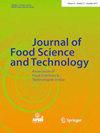Microbiological analysis of lettuce (Lactuca sativa) from conventional and organic cultivation commercialized at fairs in Brazil
IF 3.3
3区 农林科学
Q2 FOOD SCIENCE & TECHNOLOGY
引用次数: 0
Abstract
Brazilian laws established regulatory limits in lettuce only to thermotolerant coliforms (fecal coliforms) and coagulase-positive Staphylococci of 10 MPN g and 10 CFU g respectively. The objective of this study was to evaluate and compare contamination of lettuce from conventional and organic cultivation, commercialized at fairs in south of Brazil, by the fecal coliforms, coagulase-positive Staphylococci, Salmonella spp. and Listeria monocytogenes. Eighty samples of traditionally and organically produced lettuce each were collected. The contaminated samples percent were 35 and 71.25, for fecal coliforms, 35 and 32,5 for coagulase-positive Staphylococci, 0 and 5 for Salmonella spp., 2.5 and 2.5 for Listeria monocytogenes, in conventional lettuce and organic lettuce, respectively. Results indicated that 35% of the samples of conventionally produced lettuce and 71.25% of the samples of organically produced one presented fecal coliform count above regulatory limits. Coagulasepositive Staphylococci counts above regulatory limits were verified in 28 and 26 samples from the conventional and organic agriculture, respectively. Salmonella spp. was present in 5% of organically produced samples and L. monocytogenes in 2.5% of lettuce samples from both types of agricultures. Obtained results highlight the importance of good practices from cultivation to commercialization to improve the hygienic-sanitary quality of vegetables.在巴西集市上商业化的传统和有机种植莴苣(Lactuca sativa)的微生物分析
巴西法律仅对生菜中的耐热大肠菌群(粪便大肠菌群)和凝固酶阳性葡萄球菌分别制定了10 MPN g和10 CFU g的监管限制。本研究的目的是评估和比较在巴西南部集市上商业化的传统种植和有机种植莴苣的粪便大肠菌群、凝固酶阳性葡萄球菌、沙门氏菌和单核增生李斯特菌的污染情况。收集了80个传统和有机生产的生菜样本。粪大肠菌群、凝固酶阳性葡萄球菌、沙门氏菌、单核增生李斯特菌的污染率分别为35%和71.25、35%和32%、5%、0%和5%,有机生菜和普通生菜的污染率分别为2.5%和2.5%。结果表明,35%的常规生菜和71.25%的有机生菜粪便大肠菌群超标。常规农业和有机农业样品中分别有28份和26份样品的凝固阳性葡萄球菌计数超过规定限值。在这两种类型的农业中,5%的有机生产样品中存在沙门氏菌,2.5%的生菜样品中存在单核细胞增生乳杆菌。获得的结果强调了从种植到商业化的良好实践对提高蔬菜卫生质量的重要性。
本文章由计算机程序翻译,如有差异,请以英文原文为准。
求助全文
约1分钟内获得全文
求助全文
来源期刊
CiteScore
7.70
自引率
0.00%
发文量
274
审稿时长
11 months
期刊介绍:
The Journal of Food Science and Technology (JFST) is the official publication of the Association of Food Scientists and Technologists of India (AFSTI). This monthly publishes peer-reviewed research papers and reviews in all branches of science, technology, packaging and engineering of foods and food products. Special emphasis is given to fundamental and applied research findings that have potential for enhancing product quality, extend shelf life of fresh and processed food products and improve process efficiency. Critical reviews on new perspectives in food handling and processing, innovative and emerging technologies and trends and future research in food products and food industry byproducts are also welcome. The journal also publishes book reviews relevant to all aspects of food science, technology and engineering.

 求助内容:
求助内容: 应助结果提醒方式:
应助结果提醒方式:


